Interview with a Renaissance Woman:
Rose Justi
Cathy Koos
On a sweltering day in July, I had the pleasure of interviewing my longtime friend, Rose Justi, at her mountainside home in Pine Grove. Our friendship goes back almost 30 years to when our kids were littles.
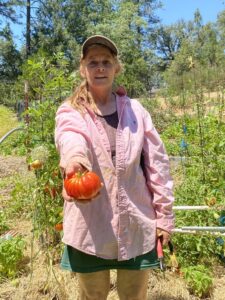
Rose sharing her garden bounty
Recently retired from a career as a charter school teacher, Rose is a weaver, spinner, knitter, dyer, organic gardener, basket weaver and experimenter. “But no paper stuff!” As a Boy Scout leader, she shared her stories of hiking with the boys while knitting, a pouch of yarn hanging jauntily off her backpack. She is equally at home peering into her microscope looking for microbes in her compost as she is carefully weighing and recording her dyeing experiments.
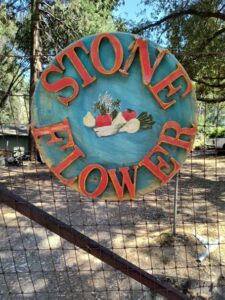
Rose’s Mountainside Garden
As a charter school educator, Rose coached team after team to Academic Decathlon competitions, science camp at Point Reyes, and living history days at Columbia State Park.
As usual when Rose and I get together, our chat becomes a rambling detour on the road of life with kid updates interspersed with our latest gardening and textile adventures.
Her Garden
Rose’s latest dyeing venture is what brought me to her Stone Flower garden last Wednesday. Rose had been sharing her dye garden on Facebook and when she mentioned growing indigo, I was intrigued. I thought indigo was a Deep South, even tropical, plant, but Rose’s garden is at almost 4000 feet elevation.
Rose told me she began her journey down the indigo road with an online class through the Maiwa School of Textiles in British Columbia last year.
There are three types of plants that give this desirable blue color: woad, true indigo and Japanese indigo and Rose directed her attention to Japanese indigo.
Her Process
Rose sourced her Japanese indigo seeds from Prismatic Seeds, as well as these other dye plants – weld and madder. Indigo is treated as an annual here and can be grown as far north as Maine and Canada.
Started inside in individual pots, the indigo achieved 100% germination. Once warm enough, The plants were moved outside to the main garden.
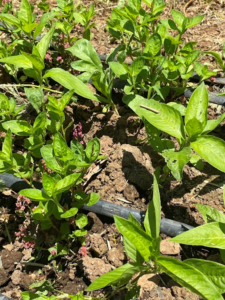
Indigo in the garden, note tiny purple flowers
After drying the indigo leaves, Rose processed it into a useable powder. Through research, she found that the dye is not accessible until oxygen is reduced. She also found that if it is too cold, pH is too low, or sugar is present, the dye is not available.
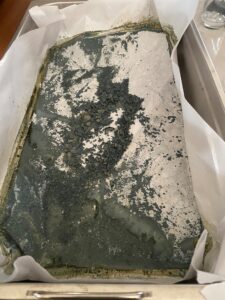
powdered indigo leaves
Indican pigment, the chemical precursor to indigo, is found in the vacuole of the leaf. Indican is achieved through either heat or fermentation in water. Hydrolysis is achieved with enzymes in the chloroplast of the leaf.
While no mordant or scouring is necessary, care must be taken to prevent oxidation as the indigo molecule will not be accessible. Water also needs to have a high pH.
Research
Rose researched the science behind indigo on web, and shares this from www.annacarolynmeier.com
“This explains why fresh leaves need to be used quickly, as any delay requires a different method like fermenting and using a vat dye process. Every leaf contains the pigment indican in the vacuoles, and an enzyme called beta glucose in the chloroplasts. When the leaves are crushed or pulverized the two compounds meet and form the pigmen indoxyl in a process called hydrolysis. The reason we need to work quickly is that indoxyl only exists while the beta glucose is present. Once it evaporates the indican is left on its own and becomes indigotin, it is no longer soluble in water and is only available to dyers by reduction in a vat, where it then becomes leucoindigo and is once again available to attached to fibers.”
Experiments
Then the experimentation began, using a fruit vat, adding tannin to the vat, and adding plant materials such as marigolds.
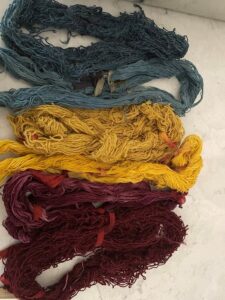
Skein samples — top to bottom – 1,2 indigo alpaca, wool, cotton; 3,4 marigold; 5-6 cotton, alpaca Lac insect.
Lac dye is a deep red colorant that comes from the resin of the lac insect, Laccifer lacca, which is native to Southeast Asia. The female lac insect secretes a resin that covers its colony on host trees, such as banyan and juniper trees, in a resinous cocoon called “sticklac”. The sticklac is then harvested and the resin is extracted to make lac dye.
Rose kept careful records and samples, as shown here:
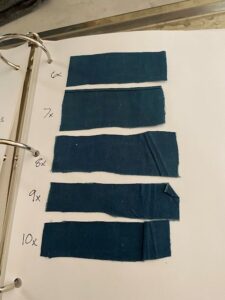
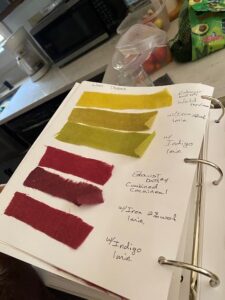
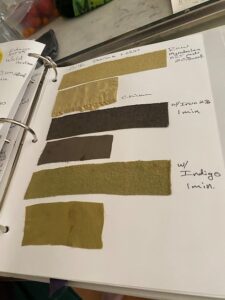
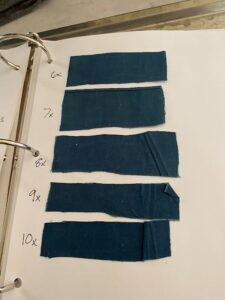
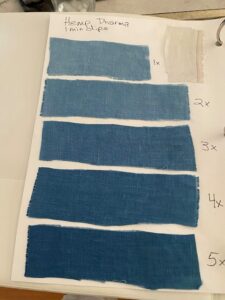
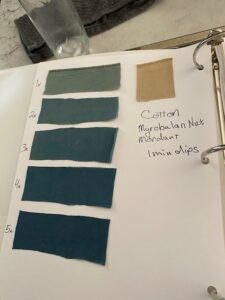
Many thanks to Rose for sharing her Indigo Journey!
References
Maiwa School of Textiles, https://maiwa.com/pages/maiwa-school-of-textiles
The Production of Indigo Dye from Plants, Nicholas Wenner, December 2017, The Fibershed
Indigo Facebook group